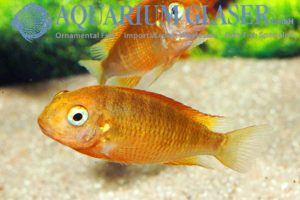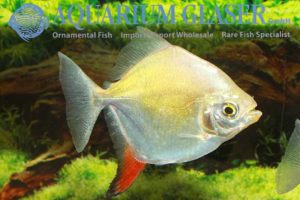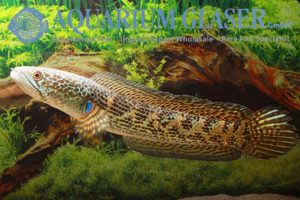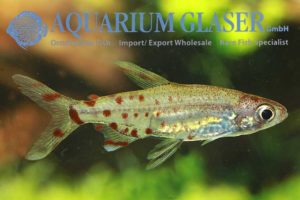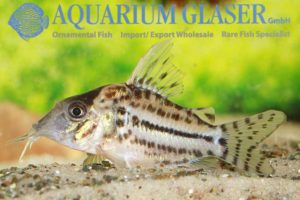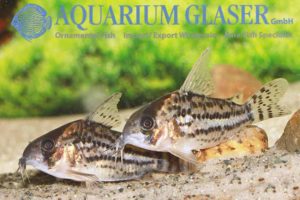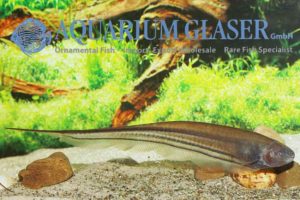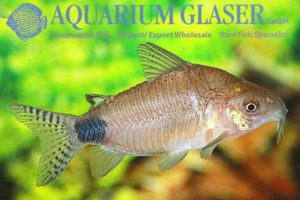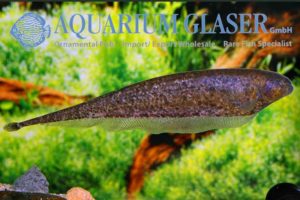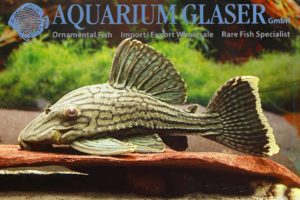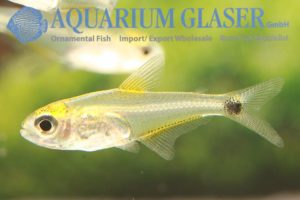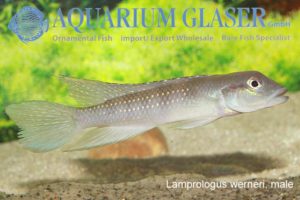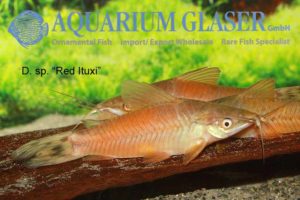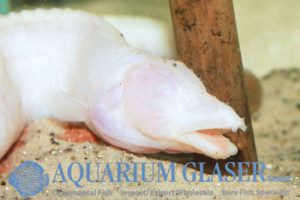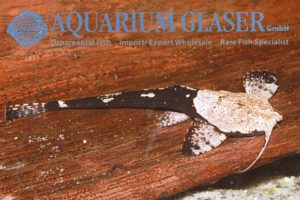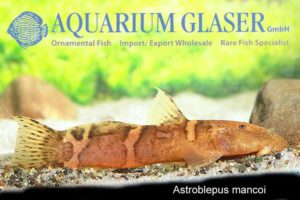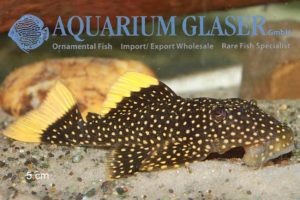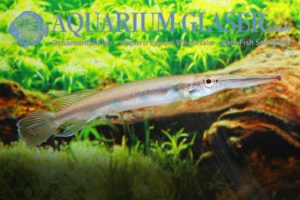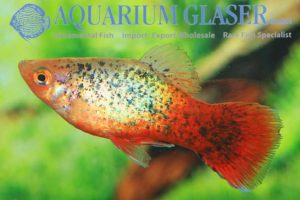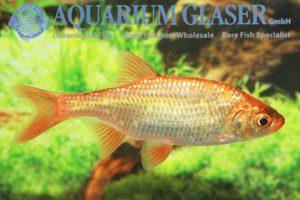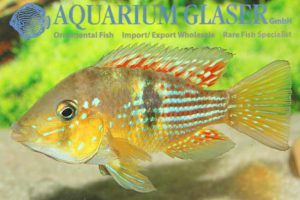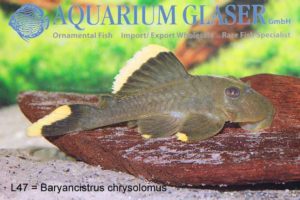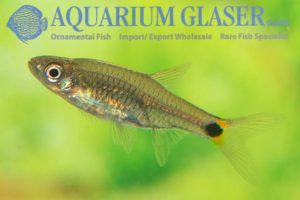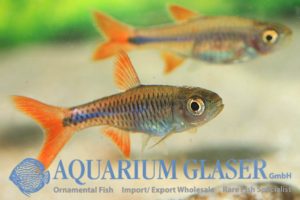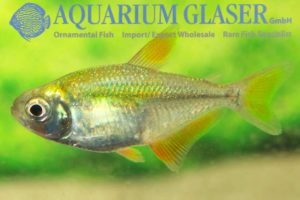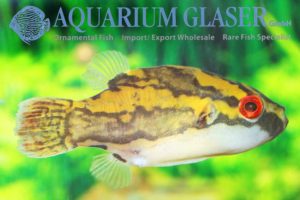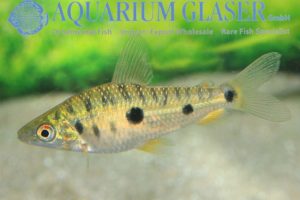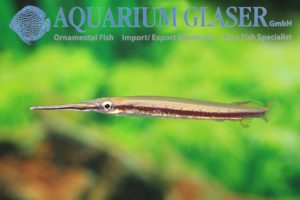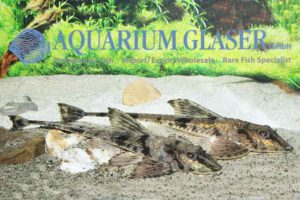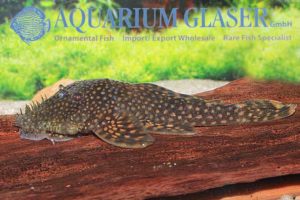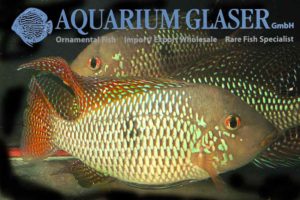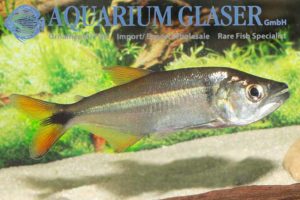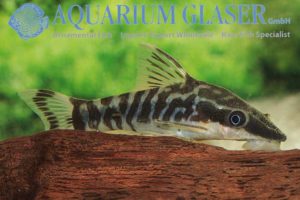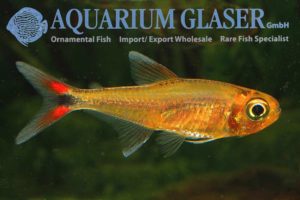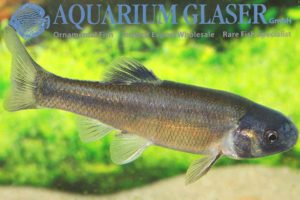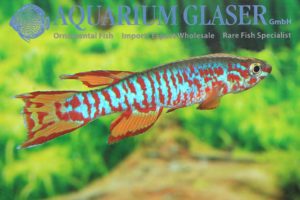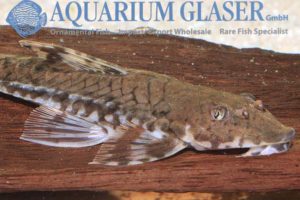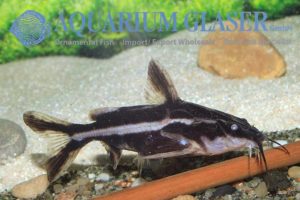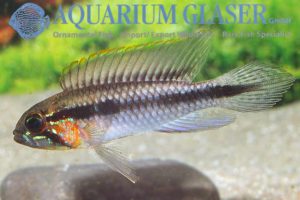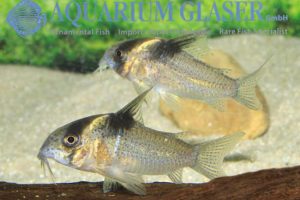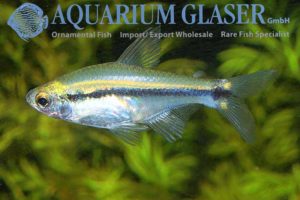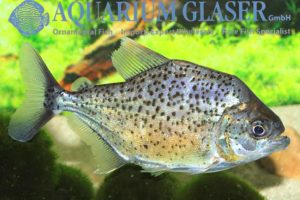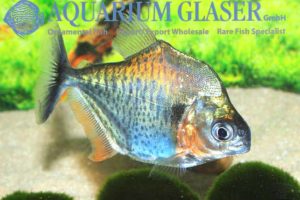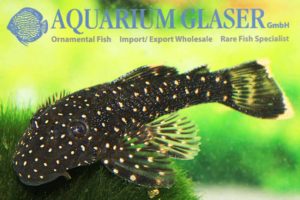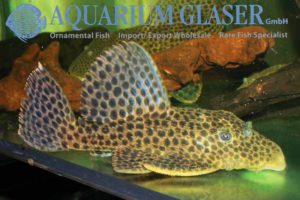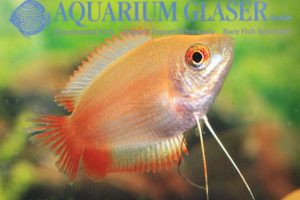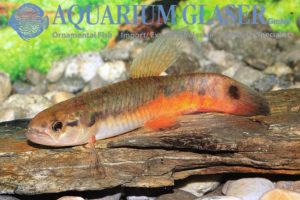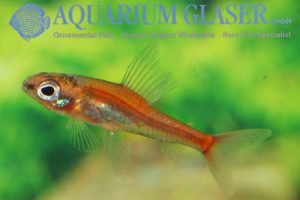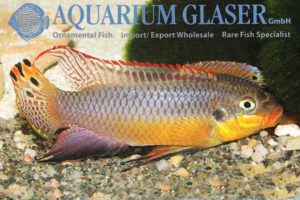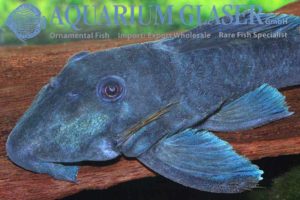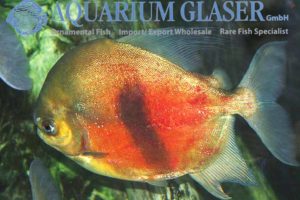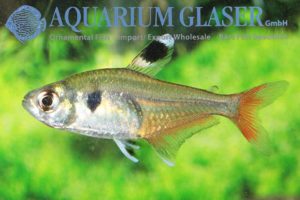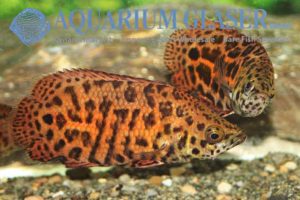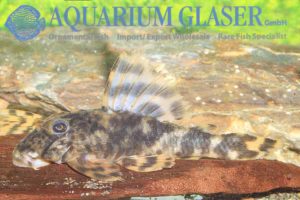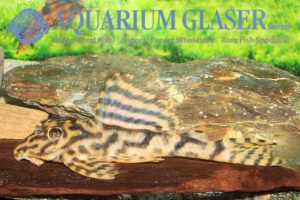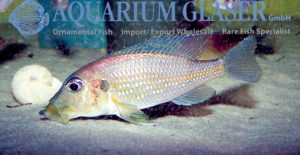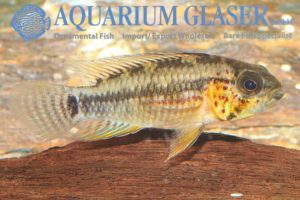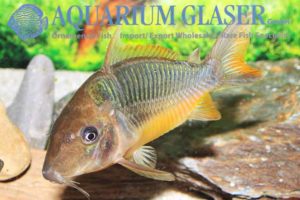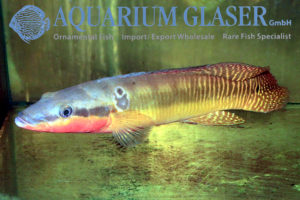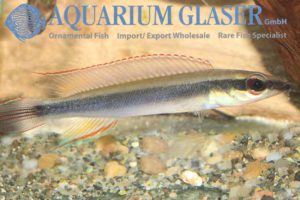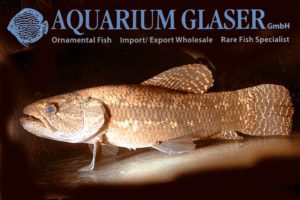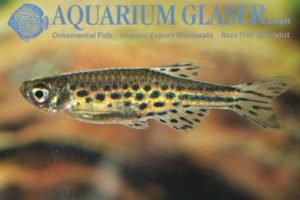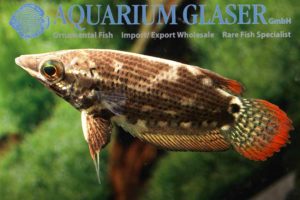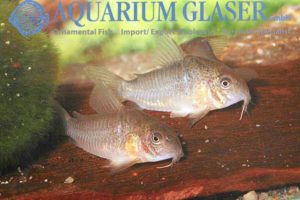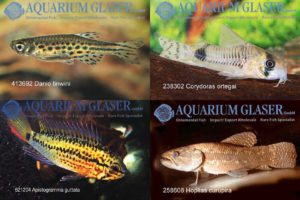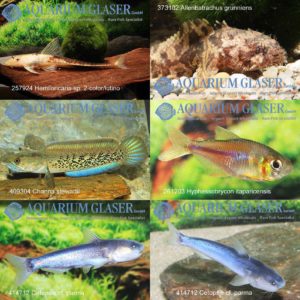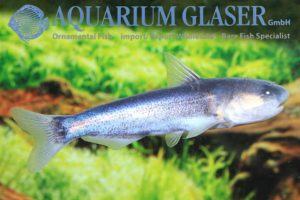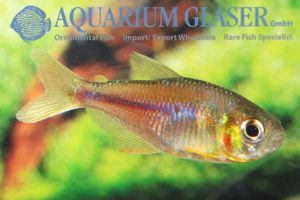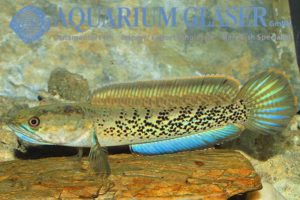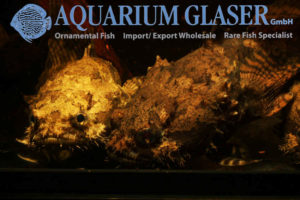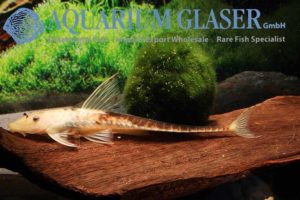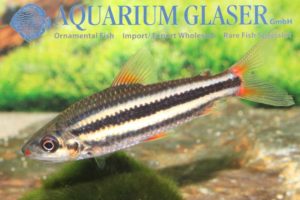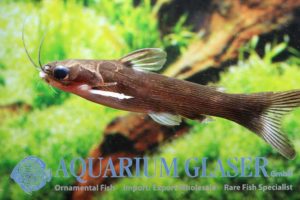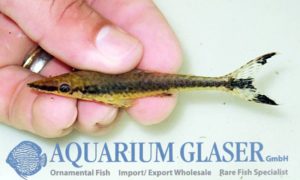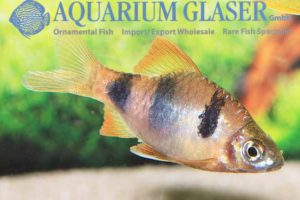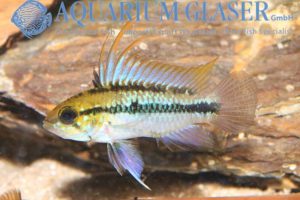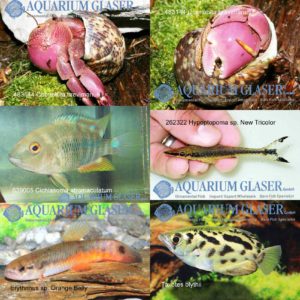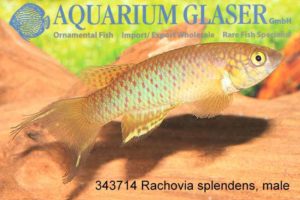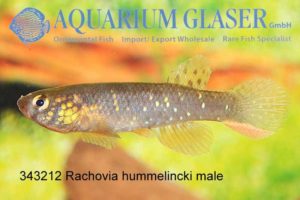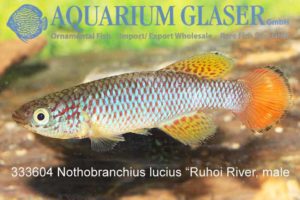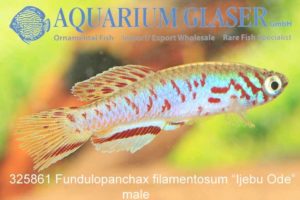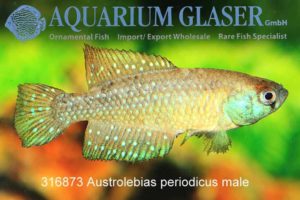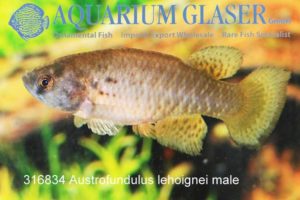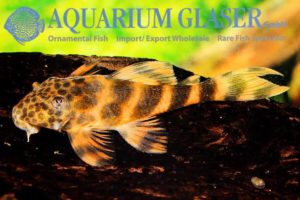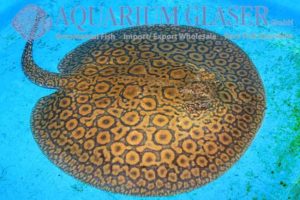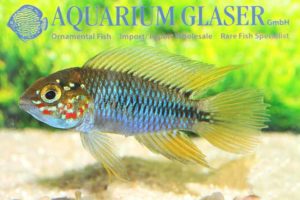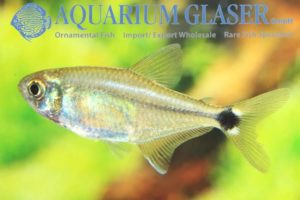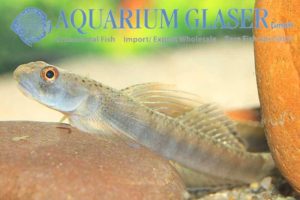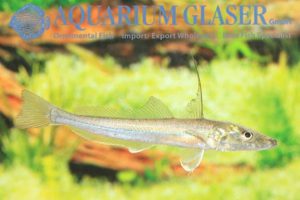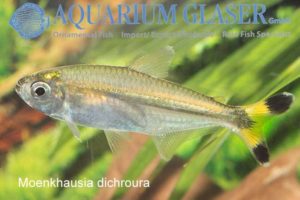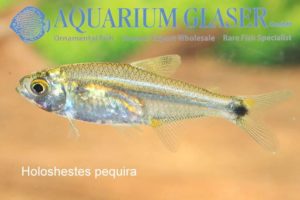For the first time ever we received this splendid snakehead, which obviously represents a species unknown to science so far. I reminds one strongly to the far spread and variety rich species C. gachua, but the “Fireback” is much bigger, reaching 15 -20 cm, it lacks the stripes in the pectoral fins, which are so […]
Fish Archive (3137)
-
-
Tropheus sp. Yellow
Currently we have extreme beautiful Tropheus sp. “Yellow” in stock which already display bright colours when young! For our customers: the fish have code 586302 on our stocklist. Please note that w exclusively supply the wholesale trade.
-
Myleus rubripinnis
We received magnificent M. rubripinnis from Venezuela, which we call “sp. rubripinnis RED” due to their intensive red colours. Code: 270392. Our specimens are 4-7 cm long. Please note that we exclusively supply the wholesale trade. Text & photos: Frank Schäfer
-
Channa aurantimaculata
Just in: one of the most beautiful of all species of snakehead, available only in limited numbers. Size up to 40 cm, our fish currently are 20-25 cm long. For our customers: the fish have code 409014 on our stocklist. Please note that w exclusively supply the wholesale trade.
-
Lepidarchus adonis
Currently we have this beautiful and extreme rare dwarf tetra (maximum length: 3 cm) in good numbers in stock. Code: 145303. Please note that we exclusively supply the wholesale trade.
-
Corydoras sp. C141
One could term this beautiful cory also the long-nose schwartzi. Obviously the species has not been described scientifically yet. It is not known from which river the fish originates. Sometime C141 is confused with C. ornatus, but the latter has never a cream-white dorsal spine. C141 attains a length of about 6 cm. Code: 241724 […]
-
Corydoras schwartzi
This good old fashioned, but still very beautiful cory originates from the system of the Rio Purus in Brazil. In contrast to the other species mentioned here the dorsal spine is only occasionally cream-white. The species belongs to the group of stout Corydoras with round noses. It can be quite easily recognized by the black […]
-
L261a – Ancistrinae gen. sp.
This species of fish is among the rarest of all L-numbers. It belongs not only to none of the species described so far, but also cannot be applied to any described genus. L261 was imported initially from the Orinoco in Venezuela. The individual we were able to import now for sure belongs to the same […]
-
Eigenmannia trilineata
We received wonderful specimens of Eigenmannia from Guyana. They show three black longitudinal stripes on a smokey ground. This fits perfectly to the pattern described in the species E. trilineata, which is known so far only from the Paraguay-Paraná system (Argentina, Brazil, Paraguay, Uruguay). May that be as it is: Eigenmannia are fantastic aquarium fish […]
-
Rachoviscus crassiceps
Finally we are able to offer once more this beautiful, but sadly only very occasionally available tetra. However, even now we have only a limited number of them. Although the fish is really beautiful – one of the most attractive features is the deep red adipose fin – this is not the main excitement for […]
-
Corydoras guapore
Sadly this charming cory is only occassionally available. We recieved once more a small number of the fish. For our customers: the species has code 230504 on our stocklist. Please note that we exclusively supply the wholesale trade. Photo: Frank Schäfer
-
Adontosternarchus clarkae
This small (maximum length up to 20 cm) knifefish from Venezuela is only rarely imported and again we were able to obtain only a few specimens. It is a very nice and peaceful species. The genus Adontosternarchus currently comprises four accepted species which can be distinguished best by differences in the head profile in combination […]
-
Panaque sp. L418 Shampupa
The magnificent Panaque species which belong to the P.-nigrolineatus-complex are much sought for ornamental fishes. All species seem to become around 40 cm long. One of the most spectacular ones originates from Peru and received the L-number 418. Characteristic features of the fish, which is called Shampupa by the exporters, is the broad light band […]
-
Characidae gen. sp. “Yellow Glass Tetra”
For the first time ever we were able to import this charming dwarf tetra from Peru, which cannot be placed in any known genus or species so far. Our largest specimens are about 1.5 cm long. Of course it is possible that our fish represent only juveniles of a larger species, but this thesis seems […]
-
Apistogramma iniridae
Sadly this beautiful dwarf cichlid is only occasionally available, but currently we were able to import once more beautiful, fully grown specimens. The fish are very stable and display all the behaviour that makes the keeping of these fish so desirable. Like its close relative A. uaupesi, which differs from A. iniridae mainly due to […]
-
Lamprologus werneri
Most hobbyists think about the cichlids of Lake Tanganyika when they hear the generic name Lamprologus. But there do exist also some species of river-dwelling (= riverine) Lamprologus. The most attractive species among them is without any doubt Lamprologus werneri, which we were able to import now once more. The slender fish is spread all […]
-
Dianema sp.
The genus Dianema comprises currently only two valid species (D. longibarbis and D. urostriata), which are pretty easy to distinguish due to the very different coloration of the caudal fin. From Brazil we now received a third species under the name of “RED ITUXI”. Obviously the collectors in the field observed that the basic colour […]
-
Caecomastacembelus brichardi
One expects blind species of fish from cave systems or the deep sea. But in the rapids of the lower Congo river not less than 5 different species of blind fish exist (among them the only blind species of cichlid of the World, Lamprologus lethops) – and nobody can explain why these fish are blind. […]
-
Pterobunocephalus depressus
This is by far the most attractive species of all banjo cats – and the rarest. We recently received the fish for the first time from Peru. It is also one of the most variably coloured species of banjo cat. Most specimens have a sharp black-and-white contrasting pattern, being white anterior and black posterior. But […]
-
Astroblepus from Peru imported!
The L-numbers or Loricariidae belong to the most popular species of catfish from South America. But even very experienced aquarists will hardly ever had the opportunity to see alive a specimen of the genus Astroblepus, although the family Astroblepidae, which includes the single genus Astroblepus, is the closest relative of the loricariids. Astroblepids are distinguished […]
-
Baryancistrus sp. L81n
We take the opportunity of the receipt of a larger shipment of L81n and the scientific description of Baryancistrus xanthellus (L18, L81, L85, L177, see http://www.aquariumglaser.de/en/news/l18_l81_l85_l177_and_l47_described_scientifically_en/) to take a closer look on L81n, which we get from Sao Felix do Xingu, once more. As in all ancistine catfish it is also true in L81n: the […]
-
Hemirhamphodon kuekenthali
Gorgeous, large specimens of this livebearing halfbeak reached us from Borneo (Sarawak) recently. The species can hardly be told apart from the better known relative, H. pogonognathus. However, we have the feeling that it is a bit stouter. But our determination bases mainly on the origin (Sarawak). Like all other Hemirhamphodon, H. kuekenthali is a […]
-
Platy Leopard
Platys with black dots are known quite long already. Initially they were termed Salt´n´Pepper-Platys, later Moskow Platys. Our reliable breeder has now developed two extreme nice strains of black dotted platys, which we call “Leopard Platys”. The first variety has a blue-green body and an intensive red tail (including the tail fin). This variety we […]
-
Scardinius erythrophthalmus GOLD
Scardinius erythrophthalmus GOLD The rudd (Scardinius erythrophthalmus) is the only species of freswater fish native in Central Europe that is specialized in feeding on soft water plants and algae. Thus it is a perfect helper for garden ponds where algae and especially duckweed should be reduced. As the rudd likes to swim in the upper […]
-
Gymnogeophagus meridionalis
Currently we have magnificent (German pond bred!) specimes of that cichlid, which is almost a dwarf cichlid (our fish are between 5-7 cm long and fully mature and in colour) in stock. There is still no agreement among the specialized aquarists, if this form represents a population of Gymnogeophagus meridionalis, G. rhabdotus or if the […]
-
L18, L81, L85, L177, and L47 described scientifically
These plecos, which originate from the Rio Xingu and its tributary Rio Iriri belong to the most popular L-numbers. Now they have been described scientifically. L18, L81, L85, and L177 belong to the same species (although L81 has not been mentioned in the paper) and have been named Baryancistrus xanthellus, whereas L47 has been named […]
-
Rasbora brittani
At the first glimpse this pretty Rasbora may look a bit colorless; however, if the fish is kept in the perfect milieu (blackwater conditions and dimmed light) it looks really beautiful. Due to a number of anatomical specializations, the species has been recently placed in a new genus, namely Kottelatia; so the most actual scientific […]
-
Rasbora lacrimula
Rasbora lacrimula For the first time ever we can offer this beautiful Rasbora, which has been described scientifically only in 2009. R. lacrimula is endemic in the Mahakam basin, Kalimantan Timur Province on Borneo. Regarding coloration this new Rasbora reminds one in R. reticulata and R. vulcanus, but R. lacrimula stays much smaller. Maximum length […]
-
Gymnocorymbus socolofi
The genus Gymnocorymbus comprises only three species, one of which – the Black Skirt tetra, G. ternetzi – is among the most popular ornamental fish. The other two species are absolute rarities. So we are glad to be able to offer one of them, the rare Gymnocorymbus socolofi from Colombia, once more. This tetra reaches […]
-
Carinotetraodon borneensis
At least we successfully imported one of the most mysterious species of freshwater pufferfish: Carinotetraodon borneensis. Although the species as been described already in 1903, it was considered over decades as a junior synonym of a closely related species, C. lorteti. However, both species look extremely similar in alcohol. In live the fish look quite […]
-
Leporinus steyermarki
Leporinus steyermarki is a beautiful large tetra. It can reach a maximum size of about 30 cm and originates from Venezuela. In German, the fish is now and then named “Grey Leporinus” which is for sure not describing accurately the coloration of the animal. Maybe this name bases on a confusion with another of the […]
-
Hemirhamphodon tengah
This pretty little fish is a challenge for experienced hobbyists. The species originates from Borneo. In contrast to the widespread prejudice halfbeaks of the genus Hemirhamphodon do not appear in brackish water; they are strictly bound to very soft and acidic water! These fishes are commonly found along with chocolate gouramis and small rasboras. The […]
-
Loricaria simillima from Paraguay arrived
Beautiful wild collected specimens of this mouthbrooding whiptail cat arrived right now from Paraguay. Read more about this fish here: http://www.aquariumglaser.de/en/fish-archive/catfish-en/loricariidae-en/Loricaria_simillima_en/
-
Ancistrus sp. L309
Finally we were able once more to import this very nice and unique member of the specious genus Ancistrus: L309. The species has not been described scientifically yet and originates from the Rio Tapajós. The fish is so different from the other members of the genus that is was even thought at times that it […]
-
Geophagus iporangensis
There are more exotic fishes that can be kept and bred at least seasonally in garden ponds than most aquarists think of. Among these species are for sure the different types of Brazilian Pearl Cichlids, the Geophagus-brasiliensis-complex. The group is only poorly understood scientifically, but who cares for names if one looks at these glorious […]
-
Oligosarcus jenynsii
This pretty predatory tetra is only imported very occasionally to Europe, although the up to 30 cm long species is quite common in the southern parts of South America (Argentina, Brazil, Paraguay, Uruguay). The photographed specimen originates from Paraguay. Basically speaking, Oligosarcus is nothing else but a Banded Astyanax (Astyanax fasciatus) that has been developed […]
-
Otocinclus cocama
The dwarfish catfishes of the genus Otocinclus are usually kept due to their algae-eating activities and their nice behaviour. The coloration of most of the species is only rather dull. Otocinclus are very famous for cleaning especially the waterplants without hurting them. Could it be that there exists a species that is not only very […]
-
Hasemania sp. Orange
After a long time we were able now to import once more this beautiful tetra from Peru. It was not possible so far to place it in a known genus or described species. We chose the name “Hasemania” only because the basic coloration of the fish is somewhat reminescent to that of the well known […]
-
Brachygobius aggregatus – one of the smallest fishes of the World
All species of bumblebee gobies (Brachygobius) are small or very small fishes. The debate which is the smallest fish of the world (and coincidently the smallest vertebrate of the world) is still going on; however, it is quite difficult to decide, whether it makes sense to debate about differences of tenth of millimeters in live […]
-
Pimephales promelas wild colored & gold
This tiny, hardly 10 cm long species originates from North America. The overall coloration is similar to that of the European minnow (Phoxinus phoxinus) in its eclipse plumage, thus the popular name “Fathead minnow” was chosen for the fish. However, there are important differences regarding life history between the two species. While the European minnow […]
-
Available soon: Aphyosemion dargei Mbam
One of our reliable killifish breeders will be able to supply us with a small number of these Aphyosemion in autumn, which are by far the most complicated ones to breed. Luckily keeping these crown jewels among the ornamental fish is pretty easy as the three males we obtained for photographing purposes in advance show […]
-
Hemiloricaria castroi
It was in August of the past year (2010) that we posted a notice on the successful importation of a wild collected lutiono of Hemiloricaria from Peru (http://www.aquariumglaser.de/en/hemiloricaria-sp-golden-lutino_de_1209.html). The animal is still living in our facility (May 2011) and has changed its coloration completely as can be seen on the new photos. Moreover, now it […]
-
Orinocodoras eigenmanni
The talking catfishes (Doradidae) are an interesting group of fishes in many ways. A lot of the species have a very contrasting pattern of dark and light elements, they can make sounds (that can be compared with a grumbling or gnarling) and their armour of bony plates often looks that bizarr that one might think […]
-
Apistogramma gephyra
This pretty blackwater Apistogramma is imported only very occasionally. Now we were able to manage one of these rare imports again. The fish originates from Brazil where it is found in the central Rio Negro and lower Rio Branco basins. A. gephyra looks quite similar to A. agassizii and its aquarium maintenance is comparable to […]
-
Corydoras cf. bicolor
This beautiful new Cory reached us from Brazil. The black- and-white pattern looks like in C. brevirostris whereas the bright orange-yellow mark on the back (right in front of the dorsal fin) looks like in the very similar species C. bicolor. However, both species do not appear in Brazil as far as it is known. […]
-
Apistogramma agassizii FIRE-RED
Currently we have wonderful, fully grown specimens of this marvelous sport in stock, originating from German breeders. The fish literally seem to glow from inside! It is very interesting that the typical polychromatism that can be observed in wild populations of this dwarf cichlid is also found in this artificial sport. Polychromatism means that coloration […]
-
Serrapinnus sterbai (=7 Rays Mint Tetra)
We imported this new, very nice and interesting tetra for the first time now from Brazil. Obviously this species originates from the Araguaia/Tocantins basin in Central Brazil. In the most current issue of the German aquarium magazine “Amazonas” (Issue 35, May/June 2011, p. 79) this fish is named “7 Rays Mint Tetra” what is adopted […]
-
Pristobrycon striolatus
For the first time ever we succeeded in importing this unique species of piranha from Brazil. Currently the piranhas are placed in 5 genera (Catoprion, Pristobrycon, Pygocentrus, Pygopristis, and Serrasalmus). However, there is some discussion about this classifaction, because intermediate forms have been observed. The species currently placed in Pristobrycon are quite discoid fish as […]
-
Serrasalmus eigenmanni Peru
Serrasalmus eigenmanni Peru This medium sized and very interesting piranha (maximum length reported is around 20 cm) was imported from Peru. This is worth mentioning, as so far S. eigenmanni has been “only” reported from Brazil, the Guyanas, and Venezuela. Our determination bases on the work by Jégu & Santos (1988). Following these authors, the […]
-
Ancistrus sp. L180 – wonderful German bred ones available
The Ancistrus species which has the code L180 is only very occasionally imported from Brazil. Obviously there is a number of very similar species existing. In AqualogNews 98 (will appear in May 2011) they will be portrayed in detail. Ancistrus sp. L180 belongs to the yellow-white spotted species of Ancistrus. Currently we have beautiful German […]
-
L234a – a new Megalancistrus
The genus Megalancistrus comprises currently only two accepted species, namely M. barrae from the Rio Sao Francisco and M. parananus, which is distributed in the triangle between Argentina, Brazil, and Paraguay. Two L-numbers have been given to M. parananus: L113 and L234. The species belongs to the largest species of Loricariids at all and can […]
-
Colisa chuna “Fire” – A new sport of the honey gourami
Currently we received this extremely cute new sport of the honey gourami from Singapore. The honey gourami is the smallest known species of Colisa and becomes only 3-5 cm long. The new variety has the yellow-golden body of the well known “Gold”-variety of Colisa chuna, but the tail, the caudal fin and the soft parts […]
-
Erythrinus sp. Madre de Dios
Finally we were successful and imported a larger number of this wonderfully coloured predatory tetra from Peru. Both sexes have the splendid orange belly. Females can be recognized by the shape of the ventral fins: they are comparatively small and rounded (large and pointed in males). It is said that the species can attain a […]
-
Odontocharacidium cf aphanes
Once more we were able to import this cute dwarf tetra from Peru. The maximum length of the fish is around 2 cm total length. Despite their small size the males can be very aggressive against each other. If one can keep a lot of them together they are peaceful (the same phenomenon can be […]
-
Pelvicachromis taeniatus Nigeria Yellow
This is another, extreme beautiful variety of that gorgeous dwarf cichlid from Western Africa: Pelvicachromis taeniatus “Nigeria Yellow”. Initially the animal originates from the surroundings of the Nigerian city of Lagos, but we have in stock fully grown adult bred ones. The bright golden breast and the very long finnage make Pelvicachromis taeniatus “Nigeria Yellow” […]
-
L 239, Ancistrinae gen. sp. Blue
We received a shipment of this very nice Pleco from Venezuela. The species becomes only 10-12 cm long. The blue iridescent fins look extremely attractive, but also the remaining parts of the body are blue-blackish coloured. It was not possible so far to place the species in an existing genus and also the species seems […]
-
Myloplus (formerly: Myleus) schomburgkii
Myloplus schomburgkii is one of the most beautiful large tetras in South America. The maximum length of these magnificent disc tetras is approx. 45 cm. The photos of the adults were taken in a display aquarium. In contrast to many other silver dollars, the identification of Myloplus schomburgkii is relatively easy, as only three species […]
-
Pseudopristella simulata
Code: 285513
-
Ctenopoma acutirostre wild
It is been a quite long time since we had the last importation of this bushfish from the D. R. Congo. Immediately after their arrival the animals had an unbelievable strong coloration. Sadly it bleached out a bit over the time, but still looks great. Read more about the leopard bushfish here: http://www.aquariumglaser.de/en/archiv.php?news_id=140 For our […]
-
Peckoltia sp. LDA61
We received this nice pleco from Colombia. It is one of the most undemanding plecos at all. The species reaches about 12 cm maximum length. This species has such a variable coloration that a lot of L- and LDA-numbers were given to it. The animals imported now with the additional name “Morruda” (spanish, means “blobber-lipped”) […]
-
Ancistomus sp. L243/LDA86
Recently we received the very nice, only rarely imported species of Ancistomus, which was given the numbers L243 and LDA86, respectively. The species is not described scientifically yet. Like most Ancistomus the species reaches a maximum length of about 15-20 cm and is thus a medium sized species of the family. Ancistomus feed mainly on […]
-
Gnathochromis permaxillaris arrived
This week we received bred specimens of this very rare cichlid from Lake Tanganjika. A breeding report can be found at http://www.aqualog.de/news/web3/3-7.pdf For our customers: the fish has code 520703 on our stocklist. Please note that we exclusively supply the wholesale trade. Lexicon: Gnathochromis: ancient Greek, means “jaw-chromis”, referring to the very special mouth structure. […]
-
Apistogramma sp. Assurini
Currently we received a new Apistogramma from Brazil, a close relative of the species known as A. sp. Xingu in the hobby. Like most Apistogramma, A. sp. Xingu, which has been imported in 1988 for the first time, has developed a number of varieties. Some of them appear within one population, others seem to represent […]
-
Brochis britskii and Brochis cf. splendens CW 35
Two features distinguish the species of Brochis from those of Corydoras: firstly, the enormous size (up to 12 cm) and secondly, the high number of rays in the dorsal fin. While Corydoras have 7-8 rays in the dorsal fin, in Brochis this fin has 10-18 rays. Besides this both genera are distinguished by some externally […]
-
First import! Crenicichla zebrina arrived
This pike cichlid was discovered only in 2002 and described scientifically in 2008. It originates from the lower Ventuari river, the largest tributary of the upper Orinoco in Venezuela. The Ventuari is a clearwater river. Although the Ventuari river is rather good sampled, the describers of that unique species were not able to obtain more […]
-
Crenicichla cf. regani Orinoco
The pike cichlids (Crenicichla) are one of the world´s most specious genera of cichlid. Currently 85 species are accepted. Many of them grow larger than 20 cm but there are also dwarf species. The beautiful, slender Crenicichla regani, which is said in literature to grow to a maximum size of 15 cm (male) or 8 […]
-
Corydoras ortegai
Code: 238302
-
Apistogramma guttata
Code: 621204
-
Hoplias curupira
Code 258608
-
Danio tinwini
Code: 413692
-
Ctenops nobilis
Chocolate gouramis are very beautiful, but demanding anabantoids. Thus they should be kept by experienced aquarists only. There are three genera of chocolate gourami, Sphaerichthys (four species), Parasphaerichthys (two species) and Ctenops (monotypical). The only species in Ctenops is nobilis, the Noble gourami from India. It represents the largest of all chocolate gouramis and can […]
-
Corydoras polystictus PANTANAL
In contrast to the typical variety of C. polystictus, which originates from the upper Rio Paraguay (state of Mato Grosso, Brazil), the Pantanal-variety has much smaller and more numerous spots. Aquarists specialized in Corydoras thus think it is possible that the Pantanal population represents a seperate species. However, even among the Pantanal corys a variation […]
-
New in stock calendar week 7, 2011
Dear customers, our weekly importations regularly content species and varieties we never or only very occassionally had in stock. Thus they are – at least for us – new. Sadly it is for different reasons not possible to portray all of them in detail. However, we want to show you at least some of the […]
-
New in stock calendar week 6, 2011
Dear customers, our weekly importations regularly content species and varieties we never or only very occassionally had in stock. Thus they are – at least for us – new. Sadly it is for different reasons not possible to portray all of them in detail. However, we want to show you at least some of the […]
-
Cetopsis cf. parma
Code: 414712
-
Hyphessobrycon itaparicensis
Code: 261203
-
Channa stewartii
Code: 409304
-
Allenbatrachus grunniens
Code: 373102
-
Hemiloricaria sp. 2-color/lutino
Code: 257924
-
Leporinus arcus
Currently we were able to organize one of the rare imports from Guyana and so we have the beautiful Leporinus arcus originating from there in stock again. The genus Leporinus contains almost 100 species and is thus pretty big. Nevertheless only very few species could establish themselves as aquarium inhabitants. Most of them become quite […]
-
Mollienesia sphenops Marble Ancient Lyratail
Code: 432182
-
Tatia strigata
Once more we were able to import a species new for for the hobby: Tatia strigata. This small species – maximum length reported is around 6 cm – has been discovered and described as late as 1995. The unique colour pattern that differs slightly individually makes the species unmistakable. As in all Tatia, males can […]
-
Hypoptopoma sp. “New Tricolor”
Only limited number available. Code: 262322
-
Barbus narayani
This extraordinary barb originates from the South of India. It is a very close relative to the well known Black Ruby Barb (Barbus nigrofasciatus) from the nearby island of Sri Lanka, from which it differs mainly by coloration. What makes B. narayani so attractive is the unique lilac-blue hue that is shining on the body […]
-
Apistogramma trifasciata
In case this dwarf cichlid would not exist it would be necessary to invent it for the aquarium hobby. Apistogramma trifasciata is an ideal aquarium inhabitant. The species stays small – males around 5 cm, females around 4 cm. It is completely undemanding regarding water chemistry – keeping and breeding is possible even in medium […]
-
New in stock calendar week 5, 2011
Dear customers, our weekly importations regularly content species and varieties we never or only very occassionally had in stock. Thus they are – at least for us – new. Sadly it is for different reasons not possible to portray all of them in detail. However, we want to show you at least some of the […]
-
Rachovia splendens
Code 343714
-
Rachovia hummelincki
Code: 343212
-
Nothobranchius lucius “Ruhoi River”
Code: 333604
-
Fundulopanchax filamentosum “Ijebu Ode”
Code: 325861
-
Austrolebias periodicus “Las Cavas”
Code: 316873
-
Austrofundulus leohoignei
Code: 316834
-
Ancistomus sp. L387 – beautiful bred ones available!
The loricariid catfish L387 is imported only occasionally and in small numbers from Colombia and Venezuela. This is due to the fact that obviously another, easily available and (at least in juvenile stages and fright coloration) very similar species occurs where L387 lives: L147. So we get wild collected L387 only as so-called by-catches. Initially […]
-
Potamotrygon sp.
We have received two beautiful stingrays from Peru which were collected in the Rio Ucuyali. Both specimens have a disc width of about 15-20 cm and are males. According to the grade of development of their sexual organs the species grows to a much bigger size. The fish do not fit any scientific description published […]
-
Apistogramma borellii
Recently we received beautiful wild collected specimens of A. borellii from Paraguay. This species is an ideal aquarium fish. In contrast to many other species of the genus A. borellii is completely undemanding regarding water chemistry. Even in medium hard, slightly alcalic water the species thrives well and even breeds. The behaviour of A. borelli […]
-
Hyphessobrycon luetkeni
Code: 259823
-
Stiphodon sp. Spotted Head
Code: 456043
-
Sillaginopsis panijus
The difference between “foodfish” and “ornamental fish” is often hard to tell. For example, who in Europe would term the zebra barb (Danio rerio) a foodfish? Nevertheless hundreds of thousands of these tiny animals are collected daily in India, become dried and are sold as a spice. On the other hand young examples of attractive […]
-
Moenkhausia dichroura
Code: 268583
-
Holoshestes pequira
Code: 258412
- « Previous Page
- 1
- …
- 24
- 25
- 26
- 27
- 28
- …
- 32
- Next Page »






